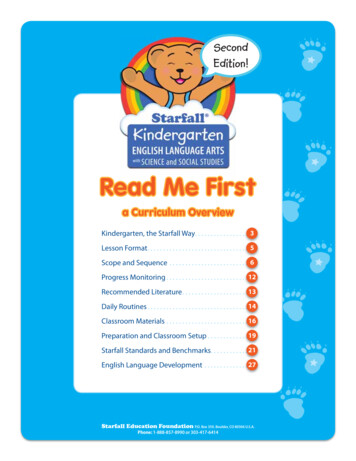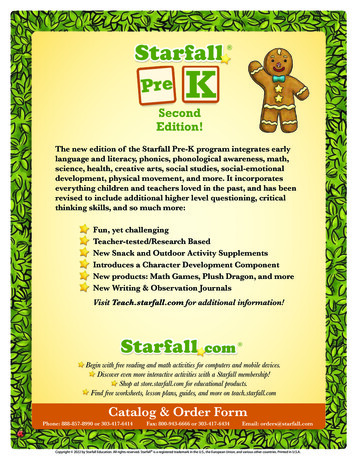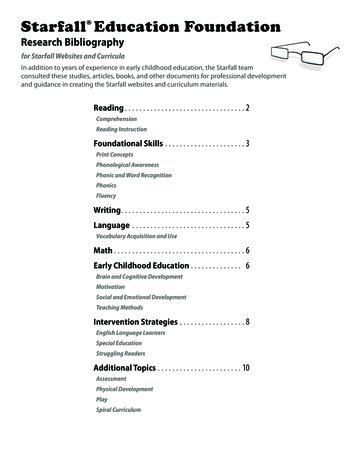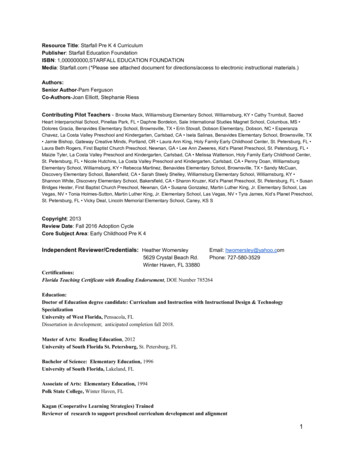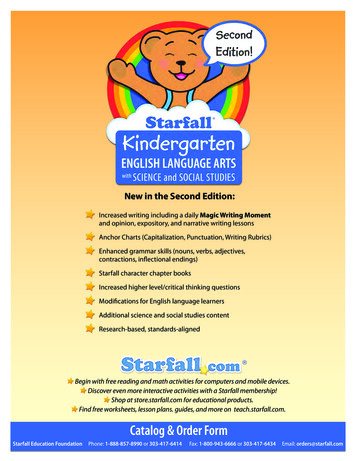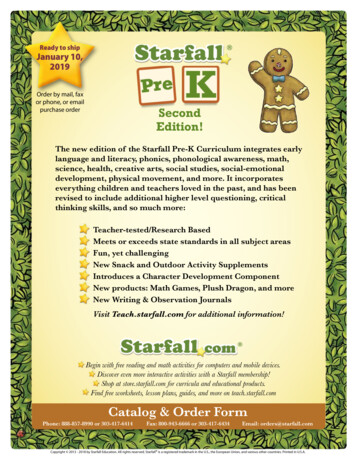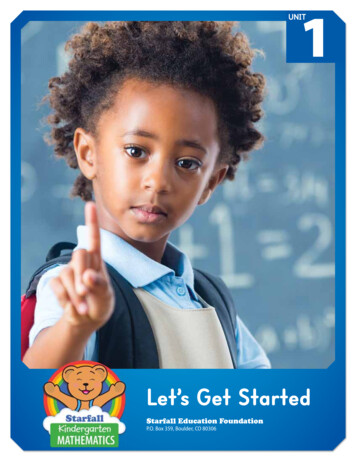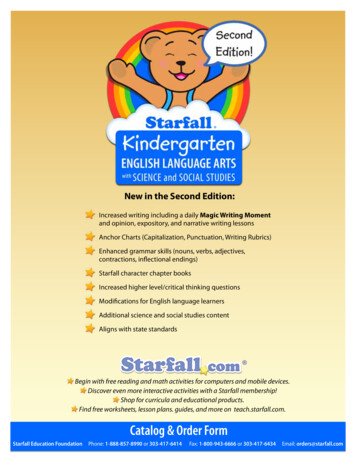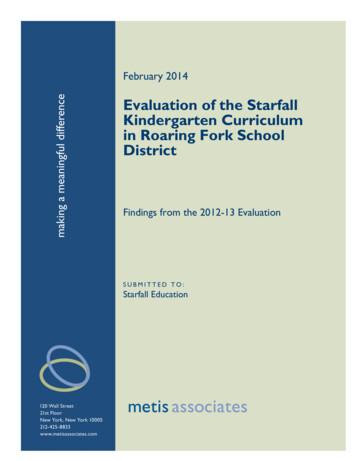
Transcription
February 2014Evaluation of the StarfallKindergarten Curriculumin Roaring Fork SchoolDistrictFindings from the 2012-13 EvaluationSUBMITTED TO:Starfall Education
Table of ContentsABSTRACT . iiEXECUTIVE SUMMARY . iiiINTRODUCTION . .1A. Background . 1B. Evaluation Purpose . 2STUDY DESIGN. 3A. Research Questions . 3B. Research Methods . . . . .4PROGRAM IMPLEMENTATION . 6A. Stakeholder Impressions of the Starfall Training and Support . 6B. Use of Curriculum Materials . 7C. Overall Impressions of the Starfall Curriculum. .11D. Impact on Teacher Practice. . .12E. Perceptions of Impact on Students . .13STUDENT OUTCOMES FROM STANDARDIZED TESTS . 15A. 2012-13 Cross-sectional analyses (same year- different schools) . 15B. Historical Cross-sectional analyses (different year- same schools) . .17CONCLUSIONS AND RECOMMENDATIONS . 20A. Key Takeaways . 20B. Recommendations. 21APPENDIX . 22i Page
AbstractMetis Associates collaborated with Starfall to develop a study to assess the implementation and overallimpact of the Starfall Kindergarten Reading and Language Arts Curriculum on student readingachievement. The study includes cross-sectional analyses of 431 Title-1 kindergarten students, 267 whoreceived Starfall instruction and 164 who did not receive Starfall. Results of the study show that asignificantly larger proportion of Starfall students achieved proficiency or higher in the springadministration of the Developmental Reading Assessment- 2nd edition (DRA-2), than did non-Starfallstudents (58.8% versus 31.1%). Starfall students also achieved significantly higher average DRA-2 scoresthan non-Starfall students (4.7 versus 3.1). Statistically significant differences were observed for all testedsubgroups including students with Limited English Proficiency status. The study also includes an historicalcross-sectional analysis by school, summary of teacher surveys, as well as a discussion of the study'slimitations and recommendations for expanded future studies.ii P a g e
Executive SummaryBased on their success with www.Starfall.com, Starfall Education developed a complete reading andlanguage arts curriculum for widespread implementation in kindergarten classrooms throughout thecountry. Developed by experienced kindergarten educators, Joan Elliott and Pam Ferguson, theKindergarten Reading and Language Arts Curriculum is comprised of paper-based and online materials(www.More.Starfall.com) that are aligned with the Common Core Standards and focus on phonemicawareness, phonics, vocabulary, fluency, comprehension and writing. In addition to the curriculum,Starfall Education provides on-site training and technical assistance to support kindergarten teachers andschool administrators with implementation. The overall goals envisioned for the Starfall KindergartenReading and Language Arts Curriculum are to motivate learning among children through an interactiveand engaging curriculum; provide opportunities for child-directed instruction in the classroom; andimprove the reading skills of all learners, including English language learners and struggling readers.In 2011, Starfall Education contracted with Metis Associates, a national research and evaluationconsulting firm, to assess curriculum implementation and the impact of curriculum adoption on studentreading achievement. For the study, Metis and Starfall Education selected Roaring Fork School District inGlenwood Springs, CO as the focus because of their recent adoption (2011-12 school year) of theKindergarten Reading and Language Arts Curriculum.To investigate the implementation and overall impact of the kindergarten curriculum, Metis designed,administered and analyzed the Starfall Teacher Survey in spring, conducted site visits, and collectedhistorical district-wide data to conduct the outcome analyses for reading achievement focusing on thedifference between students instructed with the Starfall curriculum and students not instructed withStarfall.Comparative analyses based on the implementation of the Developmental Reading Assessment- 2ndedition (DRA-2) demonstrate that Starfall students far outpaced non-Starfall students in readingproficiency for all student subgroups. Students at schools with longer tenure of Starfall implementationwere also more likely to outperform students at schools that were new to Starfall during the 2012-13school year. Additional comparative analyses of reading proficiency among kindergartens at the sameschools reveal that schools achieved higher proportions of kindergarten reading proficiency after Starfallcurriculum adoption.In the 2012-13 cross-sectional analyses, Starfall students demonstrated greater reading proficiency onthe DRA-2 than non-Starfall students across all student groups. A significantly larger proportion ofStarfall students tested at the proficient or higher levels in spring 2013 than non-Starfall students (58.8%versus 31.1%). Starfall students averaged 4.7 while the average for non-Starfall students was significantlylower at 3.1. Statistically significant differences were also observed for all tested subgroups. Largerproportions of Limited English Proficient (LEP), non-LEP, male and female Starfall students tested at theproficient or higher levels in spring 2013 than non-Starfall students.A review of the data and analyses from both the implementation and student outcome portions of theevaluation revealed a set of key takeaways and recommendations for the future which are presented inthe study. To confirm that outcomes can be generalized, Metis suggests that Starfall Education conduct astudy in other school districts of varying sizes and geography (e.g., urban/suburban) using a largerandomized controlled trial design.iii P a g e
IntroductionA. BackgroundIn 2002, the Polis-Schutz family founded Starfall Education to create a fun, engaging and accessibleresource to support early literacy among all young children. Starfall Education developed a freeeducational website (www.Starfall.com) to teach young children to read through a series of onlineinteractive games and activities, grounded in a systematic phonics approach. The website launched withmuch acclaim from teachers and educators. Based on the success of www.Starfall.com, Starfall Educationdecided to create a complete reading and language arts curriculum as an expansion of their importantwork in literacy. 1In 2009, Starfall Education successfully released their Kindergarten Reading and Language ArtsCurriculum in school districts throughout the country. Their kindergarten curriculum includes paperbased and online materials (www.More.Starfall.com) that are aligned with the Common Core Standardsand focus on phonemic awareness, phonics, vocabulary, fluency, comprehension and writing. In additionto supplying the curriculum materials, Starfall provides on-site training and technical assistance tosupport kindergarten teachers and school administrators with implementation. The overall goalsenvisioned for the Starfall Kindergarten Reading and Language Arts Curriculum are to: Motivate learning among children through an interactive and engaging curriculum;Provide opportunities for child-directed instruction in the classroom; andImprove the reading skills of all learners, including English language learners and strugglingreaders.Since the inception of the program, Starfall hasintroduced the Kindergarten Reading and “We had Houghton Mifflin as our kindergartenLanguage Arts Curriculum to a number of school curriculum before [Starfall] and it was outdated. I thinkdistricts across the country to much acclaim. it was a consensus among us that we needed a newSummer 2011 marked Starfall’s most recent program and we knew about the benefits of Starfallcollaboration with the Roaring Fork School because we’ve used it online for a few years. We wereDistrict in Glenwood Springs, CO. Glenwood excited to get it in our classrooms, especially for theSprings Elementary initially approached Starfall English language learners.” - TeacherEducation about curriculum adoption at therecommendation of one their teachers who had previous experience teaching Starfall. Glenwood SpringsElementary and other schools in the district faced ongoing challenges with preparing kindergarteners,who typically enroll in school with little exposure to reading and literacy, for first grade. Teachers wereparticularly interested in Starfall because of their positive experiences with www.Starfall.com. In the firstphase of implementation during the 2011-12 school year, the Roaring Fork School District introduced1The curriculum was created by experienced educators, Joan Elliott and Pam Ferguson. Ms. Elliott is a veteran kindergarten teacher with 30years of experience in the North Carolina and Texas public schools. In addition to the public school systems, Ms. Elliott also taught at theeducation departments at the University of North Carolina Asheville and University of Texas at Brownsville and was the recipient of theChrista McAuliffe Teaching Award and a Fulbright fellowship. Ms. Ferguson is also a seasoned educator with 40 years of experience as akindergarten teacher at the Holy Family Catholic School in St. Petersburg, Florida. She has also served on the Florida Catholic ConferenceAccreditation team since 1994.1 Page
the curriculum to all kindergarten classes at Glenwood Springs Elementary. In the 2012-13 school year,two of the three remaining elementary schools adopted the Kindergarten Reading and Language ArtsCurriculum and included all students at Sopris Elementary and a subset of students at Basalt Elementary.The remaining school, Crystal Rivers, opted out of curriculum adoption and served as a point ofcomparison in the study.B. Evaluation PurposeRecognizing the importance of evaluation in facilitating program improvement, Starfall Educationcontracted with Metis Associates, a national research and evaluation consulting firm, to investigate howthe curriculum is being implemented at schools and the impact of curriculum adoption on studentreading achievement in the Roaring Fork School District. The results of the 2012-13 study are presentedin this report and include five sections: Introduction. The first section of this report (this section) introduces Starfall and theirKindergarten Reading and Language Arts Curriculum, describes the major goals of theevaluation, and presents and overview of the structure of the evaluation report.Study design. The study design outlines the evaluation methodology and the major researchquestions.Program implementation. The program implementation section presents the majorevaluation findings from qualitative data collection endeavors, including findings around programusage, teacher opinions of the training and materials, overall impressions of the curriculum andperceptions of program impact.Student outcomes. The student outcomes section presents the evaluation findings related toreading achievement among Starfall students.Conclusions and recommendations. The final section of this report offers conclusions andrecommendations for future implementation.2 Page
Study DesignMetis Associates collaborated with Starfall to develop an appropriate study designed to assess theimplementation and overall impact of the Kindergarten Reading and Language Arts Curriculum onstudent reading achievement. The evaluation was guided by the following set of research questions andmethods.A. Research QuestionsImplementation What is the nature and quality of the implementation of the Starfall Kindergarten Readingand Language Arts Curriculum?What are stakeholders’ overall impressions of the curriculum?In what ways has the adoption of the kindergarten curriculum impacted teachers’ practicesin the classroom?To what extent (if at all) have there been perceived impacts on students since theimplementation of the curriculum?What are stakeholders’ impressions of the major challenges associated withimplementation? How can the program be improved?Student Outcomes 3 PageWhat is the impact of exposure to the Starfall Kindergarten Reading and Language ArtsCurriculum on student reading achievement?o How does the reading performance of Starfall students compare to non-Starfallstudents?o How does the reading performance of current (2012-13 school) kindergartenerswho participate in Starfall compare with the reading performance of previous (201011, 2011-12 school year) kindergarteners within the same schools?
B. Research MethodsMethods designed to address the research questions include: Administration and analysis of a Starfall Teacher Survey;School site visits; andAnalyses of student reading achievement data.Each of these methods is described briefly below.StarfallTeacherSurvey.Metismanaged the online administration of theStarfall Teacher Survey in spring 2013 toall Roaring Fork School District teacherswho adopted the kindergarten curriculumin their classrooms during the 2012-13school year. A total of 16 Starfall teachersresponded to the survey, representing an88.9 percent response rate. Table 1presents the response rates by school.Table 1. Teacher Survey Response RatesElementary SchoolNumberResponseCompletedRateBasalt (N 5)7100%Glenwood Springs (N 5)480.0%Sopris (N 8)562.5%All Schools (N 18)1688.9%Data from the teacher survey reveal that respondents have an average of 11 years of experience as afull-time teacher and one year of experience teaching the Starfall kindergarten curriculum. Whilerespondents taught a range of students at their schools, the majority instructed general educationstudents (87.5 percent) and/or English language learners (62.5 percent). Almost a third of teachers alsoinstructed special education students (31.3 percent).School Site Visits. In April 2013, a researcher from Metis conducted school site visits at each of thethree implementing elementary schools, which included the following activities: focus groups with a total of 23 teachers,interviews with four school administrators (four principals and an assistant principal), andschool tours, including classroom observations and informal conversations with studentsand teachers.Student Reading Achievement Data. The Metis research team acquired historical district-wide datato conduct the outcome analyses for reading achievement. Student demographic data (e.g., sex,race/ethnicity, Limited English Proficiency status), and end-of-year Developmental Reading Assessment 2nd edition (DRA 2) scores were collected for the 2010-11, 2011-12 and 2012-13 school years tofacilitate two separate sets of outcome analyses: 2012-13 Cross-sectional analyses (same year – different schools) focused on thedifference between students instructed with the Starfall curriculum 2 and students notinstructed with Starfall 3. Direct comparisons of DRA 2 achievement between the Starfall andnon-Starfall students were conducted while accounting for possible subgroup (e.g., Limited2The “Starfall” group: Students at Glenwood Springs, Sopris, and approximately half of the students at Basalt3The “non-Starfall” group: Students at Crystal River and the remainder of the students at Basalt.4 Page
English Proficient, sex) differences. Further analyses were also conducted based on years ofschool experience with the curriculum to determine whether school “comfort level” withcurriculum implementation had an effect on achievement. 4 Historical cross-sectional analyses (different years – same schools) focused on thedifferences between school performance before and after Starfall implementation. Theseanalyses compared student DRA 2 performance in the 2012-13 school year to studentperformance in the school year prior to Starfall curriculum implementation 5. To furthercontrol for the possible confounding effects of differences between student populationsfrom year to year, propensity score matching techniques were utilized to equate studentgroups on key characteristics such as sex, race/ethnicity and Limited English Proficiency.4Analysis methodologies used to compare outcomes for groups included Yates chi-square, t-tests for independent samples, analyses of varianceand multiple linear regressions. Group summary statistics and values for appropriate test statistics are provided in Appendix B.5For Basalt and Sopris, the school year prior to Starfall implementation was 2011-12. For Glenwood Springs it was 2010-11.5 Page
Program ImplementationThis section includes a summary of the implementation findings, beginning with stakeholder impressionsof the curriculum training and support, an assessment of teachers’ use of the Starfall Reading andLanguage Arts Curriculum materials and resources, overall impressions of the curriculum, and adiscussion of the perceived impacts of Starfall on teacher practice and perceptions of impact onstudents.A. Stakeholder Impressions of the Starfall Kindergarten CurriculumTraining and SupportStakeholders generally felt that Starfall provided a range of quality training and technicalassistance to support curriculum implementation. Teachers felt well supported and werecomfortable with using the kindergarten curriculum in their classrooms. Prior to and during curriculum implementation, Starfall offered a range of training and technicalsupport to schools, including:oSpring 2012 training. The initial half-day, on-sitetraining introduced new teachers to the kindergartencurriculum, which included an overview of thecurriculum materials and general instructions onhow to implement it in the classroom. Second yearcurriculum adopters from Glenwood SpringsElementary School also shared their experienceswith teachers who were new to Starfall.oFall 2012 training. The second half-day, on-site training session focused moreextensively on the day-to-day curriculum implementation through the lens of theTeacher’s Guide. The Starfall trainer reviewed the Teacher’s Guide, discussed thestructure of the units and lessons, and advised teachers on ways in which they canmodify activities or lessons to address possible time constraints in the field.oSchool site visits. In spring 2013, trainers visitedthe three implementing schools to observe individualStarfall classrooms and meet with teachers to discusstheir experiences with the curriculum and solicitfeedback on ways in which the curriculum could beimproved.oTechnical assistance. Starfall trainers wereaccessible to teachers and administrators via phone and email throughout the schoolyear. Teachers most frequently contacted Starfall trainers about missing curriculumcomponents and additional literature sources cited in the materials.“I think the people from Starfallbuild nice relationships andrapport with us as a schoolcommunity.This was a bigstrength. Often times it can feelvery corporate working withcurriculum folks.” - Principal“We could always email them[Starfall trainers], if we hadquestions. We had iPad issues atthe beginning of the year. Wementioned it, and it was fixedliterally within three days.” TeacherData from the site visit interviews and focus groups suggest that Starfall offered high qualitytraining and technical assistance. Teachers and school administrators described the trainings6 Page
as “informative,” were comfortable providing feedback to Starfall on the curriculum materials andgenerally felt well supported by Starfall staff. The majority of teacher survey respondents reportedthat:oooStarfall training was relevant to their work (78.6 percent);They were sufficiently trained to use Starfall in the classroom (60.0 percent); andThey felt supported in their use of Starfall (76.7 percent). The effectiveness of the training is clearly reflected in the teacher survey data. Most teachersurvey respondents (93.8 percent) noted that they were moderately or very comfortable with usingStarfall in their classrooms. When asked about additional training and support needed, some first-year Starfall teachersthought that they could have benefited from modeling or observing classrooms prior toimplementation. In contrast, other first- and second-year Starfall teachers believed Starfallprovided all necessary training and supports, and that no additional assistance could replace theiryear of experience with implementation.B. Use of the Starfall Curriculum MaterialsTeachers regularly implemented the Starfall Reading and Language Arts Curriculum and usedapproximately half the materials, tools, and resources in their instruction. Teachers oftenmodified the activities or supplemented lessons with additional materials and resources toaddress students’ varied individual needs. Overall, teachers found the curriculum materials easyto use. Data from the teacher survey show that, on average, respondents used the Starfall kindergartencurriculum on a daily basis for an average of 64 minutes per session. During the site visit focus groups, both first- and second-year Starfall kindergarten teachersindicated that they did not find it necessary to implement the curriculum strictly as outlined in theTeacher’s Guide. Because the materials are flexible, teachers often made modifications based onthe needs of their students or time constraints. For example, teachers may have:ooOpted to implement whole group activities in asmall group, or vice versa because certain groupsof students required additional attention.Skipped activities or changed the sequence ofactivities based on the pace of their students orthe limited time available for the lesson. (E.g.Teachers sometimes skipped the science andsocial studies content because of timeconstraints.)“At first I followed along with the units,the letters being introduced, and the sightwords. But then we started implementingsight words much earlier than advisedbecause they needed to know them muchearlier. Then, I followed along with thebooks and the theme of it, but then Iusually create my own activities becauseof the time frame. —TeacherWhile all teachers may have skipped some of the curriculum activities, second-year Starfallteachers were more comfortable with doing so than first-year Starfall teachers.7 Page
In addition to the curriculum modifications, teachers often supplemented Starfall with othermaterials. As shown on the teacher survey, 93.8 percent of the respondents supplementedtheir literacy lessons with other resources to address the needs of struggling or advancedreaders. These materials include:oooooo Guided reading books to address phonological awareness;Writing curriculum (e.g. Lucy Calkins) to better address the Colorado state writingstandards;Read aloud books to include in daily instruction;Additional centers to address students’ varied needs;Levelled books and readers for struggling readers, andTheir own assessments to better ascertain if they are adequately addressing theColorado state standards.A closer examination of the teacher survey data further suggests that teachers adopted a “pickand choose” approach to curriculum implementation.oAs shown in Figure 1, the majority of teacher survey respondents integrated nearly halfof the Starfall wall reference items/daily routine organizers (4 of 9 items or 44.4percent) by the end of the 2012-13 school year.Figure 1: Percentage of Teachers who Integrated the Starfall Wall Reference Items/DailyRoutine Organizers in their Classroom (N 16)Letter formation and sound spelling cards93.8%American Sign Language reference poster81.3%Sound spelling poster68.8%Animal kingdom posters56.3%Historical figure posters50.0%Starfall word wall37.5%CalendarWeather chartClassroom responsibility arly, respondents consistently implemented most of the Starfall hands-on andtechnology materials, tools, and resources (16 of the 29 items or 55.2 percent) (Figure2). In particular, teachers regularly used the following types of curriculum materials: 8 Page20.0%Teacher’s Guide Lesson PlansBackpack Bear’s Daily Message
Plush Characters (Backpack Bear, Zac the Rat, Peg the Hen, Mox the Fox, TinMan and Gus the Duck)Phonics Instruction Tools (Sound-spelling instructional cards, word/picturecards)Sentence Strips and Word Cards (Sentence strips/word cards and predecodable books)Figure 2: Percentage of Teachers who Consistently (At Least a Few Times per Week) UsedVarious Starfall Curriculum Materials and Tools in their Classroom (N 14)Starfall website93.3%Phonics books92.9%Teacher's Guide lesson plans86.7%Predecodable books85.7%Box set of short vowel books84.6%Plush characters81.3%Teacher's Lounge generator80.0%Box set of decodable Learn 78.6%Sound-spelling instructional 78.6%Reading and writing block 75.0%Starfall melodies CD69.2%Listening and writing block 68.8%Sentence strips/word cards66.7%Cut-up/take-home sets66.7%Starfall Writing Journal56.3%Backpack Bear's Daily 0.0%o20.0%40.0%60.0%80.0%100.0%Curriculum components that teachers used less frequently included: 9 Page53.3%Games (Starfall Speedway, Alphabet Avenue, short vowel puzzles, and storyelement cards)Read-aloud books (Plant and animal kingdom books, Starfall Read Aloud Books,and recommended literature)
Media resources (Starfall Sing-along book and CD and Starfall Writer MelodiesCD)Margaret Hillert’s beginner readers “I’m Reading” setsWhen asked about how easy it was to use the kindergarten curriculum materials, teacher surveyrespondents reported that the vast majority of materials were very easy to use (26 of 30 itemsor 86.7%) (Figure 3).Figure 3: Percentage of Teachers who Found the Starfall Materials Very Easy to Use (N 14)Teacher's Lounge generator100.0%Starfall melodies CD92.9%Box set of short vowel books92.8%Box set of decodable Learn to Read books92.8%Reading and writing block print text92.8%Listening and writing block print text92.8%Starfall Writing Journal92.3%Starfall website86.7%Phonics books86.7%Word/picture cards86.7%Plush characters86.7%Sound-spelling instructional cards85.7%ABC Rhyme book85.7%Short vowel puzzles85.7%Plant and animal kingdom books84.6%Starfall Read Aloud books78.6%Starfall sing-along78.6%Recommended literature books for read aloud73.3%Backpack Bear's Daily Message69.2%Starfall Speedway game66.7%Alphabet Avenue game66.7%Cut-up/take-home sets66.7%Predecodable books64.3%Story element cards64.3%"I'm Reading" sets61.5%Bi-weekly assessments0.0%10 P a g e53.3%20.0%40.0%60.0%80.0%100.0%
oRespondents deemed all items at least moderately easy to use, with the exception of theStarfall Dictionary. Survey feedback on the Starfall Dictionary mirrored feedback fromteachers during the site visit focus groups. Teachers noted that the dictionary wasinappropriate for many of their students, especially at the beginning of the year. Oneteacher explained, “At the beginning of the year, some kids did not know their letters, sowriting in the dictionary was difficult. By mid-year, I was able to use it as an independent center,in which they took words from the word wall.”C. Overall Impressions of the Starfall Kindergarten CurriculumTeachers found Starfall to be more effective than previously adopted curricula in addressing thevaried needs of their students. Overall, teachers were satisfied with the Starfall kindergartencurriculum and would opt to continue implementation in the following school year. Teachers and administrators felt that Starfall better addressed the needs of theirkindergarteners than did previous curricula. Although the Starfall curriculum proved to bedifficult for many of their students at the beginning of the school year, teachers found that eventhe lowest level readers benefited from the program by the end of the year.o“I think it's challenging for many of our students, especially our lowest achieving ones. But Ithink it's so engaging that they're learning more than we've ever seen them learn with any othercurriculum. So, while I don't think the curriculum is necessarily exactly designed for our lowestlevel learners, I don't think we want a curriculum that's only designed for our lowest levellearners, either.”- Teachero“The materials are much more visual and engaging than our previous curriculum. And I've seenthat piece very differently defined than it was with our previous curriculum. I've seen moreenthusiastic teachers feeling like they have a curriculum that better meets the needs ofstudents.”-PrincipalReports from the teacher survey and site visit focus groups indicate that the followingcomponents were especially helpful in aiding st
In addition to the curriculum, Starfall Education provides on-site training and technical assistance to support kindergarten teachers and school administrators with implementation. The overall goals envisioned for the Starfall Kindergarten Reading and Language Arts Curriculum are to motivate learning among children through an interactive


